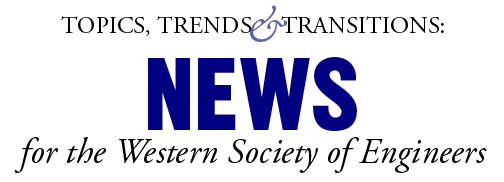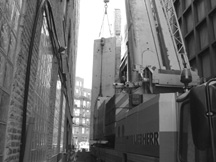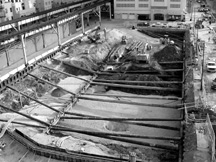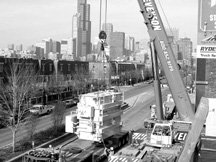












2002 Award Nomination Forms Now Available!
Know someone worthy of the high honor of the Washington Award, Ellet Award, or the Landmark Award? Want to enter a paper for consideration for the Chanute Award? Click below to get your copy of the nomination forms now.
Midwest Engineer wins highest awardMidwest Engineer has won the Distinguished Award, the highest award in an individual category, from the 29th Annual Chicago Technical Publications, Art, and Online Communication Competition, sponsored by the Society for Technical Communication. The judges indicated that the magazine was �clearly superior in all criteria,� and one judge even commented that the magazine was so interesting that she would buy it if she saw it on the newsstand. As a recipient of the Distinguished Award, Midwest Engineer is now entered into the International Technical Communication Competition (ITCC). Chanute and Ellet AwardsThe Octave Chanute Award is given annually to the Western Society member whose paper on an engineering topic is judged meritorious. In 1901, during his term as WSE president, Chanute, an aviation pioneer, funded the cost of awarding a commemorative medal to the Society member who presented the best research paper before the Society each year. The following year, as retiring president of the Society, he established an endowment to fund future awards. Today the Society bestows up to three awards each year to members for meritorious papers in all fields of engineering. A list of rules governing the Octave Chanute Award is available in the WSE office. Papers must be received by May 31, 2002. The Charles Ellet Award is presented annually to a member of Western Society of Engineers who is 35 years of age or younger and who has made outstanding progress in his or her professional development. The award consists of a certificate, a small cash award, and the engraving of the recipient�s name on a silver loving cup. WSE members who are eligible for nomination for the Charles Ellet Award this year are:
WSE�s 25th Invitational Golf OutingMark your calendars for July 22, 2002, to participate in WSE�s 25th annual Invitational Golf Outing at Itasca Country Club. Fee: $500.00 per foursome. This is a sellout event, so get your reservation in early. For more information, contact the WSE office at 312/913-1730 or [email protected]. January Engineers Forum luncheon: ComEd�s Upgrade of the Central LoopThe January Engineers Forum luncheon featured a panel of three speakers who have been working together to upgrade the power transmission system of the central city.
Rowe listed the plan�s goals:
These goals were to be accomplished by improving ComEd service, working closely with the city, gaining customer trust, and implementing cost savings. The tangible results are new substations and new transmission lines. Before these could be built, however, ComEd had to deal with several issues. Zoning questions arose when sites were selected. In addition, the utility had to deal with NIMBY (not in my backyard) issues; when ComEd needed to build a substation in an upscale residential area, the company, according to Rowe, �became very good with flowers and plants.� Architectural aesthetics also had to be considered; the new facility had to fit into the neighborhood with appropriate exterior design and attractive landscaping. Examples include the Kingsbury substation at the I-90-94 Ohio feeder ramp; it was built adjacent to a park, which ComEd renovated afterward. The State Street substation at 14th Street was also built so that the public would not recognize it as a substation from the outside. The results of this upgrading plan have been very favorable: no major outages in the central business district in 2001, decrease in service interruptions by 35 percent and in interruption duration by 72 percent, and community approval of the undertaking. Karl Miller of Kenny Construction outlined the construction challenges for this project. Searching for underground utilities was an enormous job that was hampered by the city�s time limits on how long a street could be torn up. Soil conditions, including shoring and retention problems as well as contamination, also presented challenges. The proximity of neighbors had to be considered. For instance, the Kingsbury station is next to a warehouse that stores rare wine that can be damaged by vibrations. Kenny installed a vibration monitoring device, and there was no spoiled wine. Quality and safety on the job were Kenny�s main objectives. Safe work plans, ongoing training, and regular drug testing were part of the routine. Kenny also instituted numerous daily inspections since safety incentives were tied to the ComEd contract. Marty Dore of Sargent & Lundy spoke about his firm�s role in meeting the engineering challenges of this project. Sargent & Lundy was responsible for selecting property size and location; meeting the requirements of the city, alderman, and residents; checking the reliability of the design; overseeing the safety of the operation; maintaining the schedule; evaluating risks; and keeping costs down. Sargent & Lundy saw to it that the design, construction, and testing were a team effort. The contract with ComEd allowed selection of contractors of choice, all of whom were involved from the beginning. This led to cost effectiveness as well as to cooperation and a working atmosphere based on trust. WSE board member wins award
The prestigious award is the association�s highest honor, recognizing a lifetime of outstanding contributions and loyalty to Purdue University, the engineering profession, and the community. Burke chaired the Purdue Civil Engineering Advisory Council and serves on the advisory council of the Civil Engineering Program at University of Illinois at Chicago. He frequently teaches hydraulics and hydrology courses at Purdue University, has taught at the Illinois Institute of Technology, and is currently an adjunct professor at the University of Illinois at Chicago. In 1998 he received the Distinguished Engineer Alumni award from Purdue University and was similarly honored in 1995 by the School of Civil Engineering. With the dedication in 1999 of the Christopher and Susan Burke Hydraulic Laboratory at Purdue, Burke reaches out to countless future generations of civil engineers. �I�ve benefited a great deal from my Purdue engineering education,� said Burke. �I think young people should take advantage of the opportunities that present themselves. While much of the hard work may not be immediately rewarded, it can pay dividends in character buildup. We�ve grown very attached to Purdue, and I�m happy to be in a position to give something back.� Burke is active in professional societies, having held (or currently holding) leadership positions in Western Society of Engineers, American Society of Civil Engineers, Consulting Engineers Council of Illinois, Illinois Road Builders Association, and Illinois Association of Environmental Professionals. A recognized expert in water resources, Burke and his company provide municipal, civil, mechanical, environmental, and structural engineering services to public and private sector clients in Indiana and Illinois. Archived Society News
|
calendar • about wse • engineering news • professional development • resources • home
All content copyright © 2007-2008 Western Society of Engineers. All rights reserved.
Western Society of Engineers
1111 Burlington Avenue, Suite 102
Lisle, Illinois 60532-1290
630-724-9770 • 630-241-0142 fax
[email protected]





 WSE board member Christopher B. Burke, PhD, PE, founder and president of Christopher B. Burke Engineering, Ltd in Rosemont, Illinois, is the recipient of the 2001 President�s Lifetime Award of Purdue University�s Engineering Alumni Association.
WSE board member Christopher B. Burke, PhD, PE, founder and president of Christopher B. Burke Engineering, Ltd in Rosemont, Illinois, is the recipient of the 2001 President�s Lifetime Award of Purdue University�s Engineering Alumni Association.